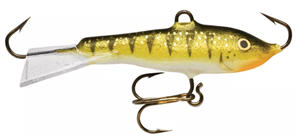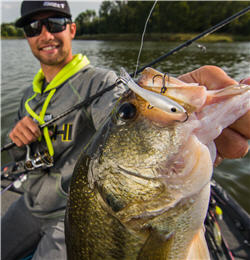
There are many ways to catch bass in deep water. A jigging spoon or drop-shot rig are common choices, but jigging minnows, like the Rapala Jigging Rap, are gaining popularity. We've asked two pro anglers, Jacob Wheeler and Brandon Palaniuk to share their sonar tips and jigging tricks for vertically fishing the Rapala Jigging Rap to catch big bass.
A Fishing Lure With Action for Bass

jig for suspended fish with Rapala Jigging Rap
The Rapala Jigging Rap’s origin is as an ice fishing bait. Yet, the characteristics that make it deadly on ice - its fast sink rate, minnow profile, and unique to-the-side darting and gliding action - are just as effective in straight-down scenarios for deep bass.
“Snap your rod and it will dart a foot or two off to the right and then continue falling fast,” said Bassmaster Elite Pro, Brandon Palaniuk. “Snap it again and it might dart two feet back over to the left, or forwards, or backwards. For fish that are in a negative, inactive mood, that erratic action triggers a feeding response.”
Watch video Brandon Palaniuk using a Rapala Jigging Rap for bass in open water
“It’s about showing fish something different, and that’s what that Jigging Rap does for bass,” said Jacob Wheeler, who secured a top-15 finish at the February 2015 Bassmaster Classic on Lake Hartwell, using a Rapala Jigging Rap Glow, #7 (5/8 ounce) version to work the edges of flooded timber in 30 to 40 feet of water.

“At times, the fish wouldn’t eat a drop-shot or jigging spoon,” Wheeler said. “That was when the Jigging Rap was key to me getting them to bite.”
Extra Tip: This “ice” lure isn’t just for cold water. Palaniuk used a #7 Jigging Rap to secure a Bassmaster Elite Series top-10 finish on New York’s Lake Cayuga in 2014.
Getting Precise With Marine Electronics
Electronics are key to how both pros vertically fish bass with a Jigging Rap. Channel swings near long sloping points are prime areas for this tactic Palaniuk explores with a Humminbird fish finder to locate baitfish and bass. Wheeler uses a Lowrance HDS LIVE 12 Fish Finder/chartplotter to find bass in deep, wintering holes or around brush piles. After fish are located, out comes the Jigging Rap for a straight-down bass smackdown.

Palaniuk Uses: A Humminbird fish finder to position the boat over individual fish, then drops the lure into its strike zone. Watching the screen will show a lure’s depth and fish response, which in turns helps refine tactics to trigger a reaction strike.
“Usually I’ll start with the bait right there in the fish’s face,” Palaniuk said. “I’ll drop it maybe four to five inches above the fish. Then rip it up and let it fall right back into his face, or right below. If that doesn’t work, I’ll go slightly above them, so that bait’s just dropping a foot within their head.”
Wheeler Uses: A Jigging Rap when bass are grouped together and competing for food. Watching his Lowrance HDS-12, he uses a come-and-get-it approach by aggressively snapping a Jigging Rap four to five feet above fish. This forces an interested bass to make the commitment to swim up to the bait and, once a bass is committed, it’s more likely to strike, especially when Wheeler slams on the brakes, causing the lure to naturally glide downwards.

Combo Pack with Scale
“Those fish come up and when they get up to the bait and you stop it, it starts to glide a little bit, and that’s when you get bit. Then you pull up, and you got ‘em,” Wheeler said.
Extra Tip: Increase sonar sensitivity as needed to achieve a strong signal and easily see the lure and bass on the unit’s display.
Palaniuk & Wheeler Recommend Well Balanced Fishing Gear
Properly presenting a Jigging Rap and bringing in big bass from deep water requires a well balanced rod outfit. Here’s what the pros use to get the job done.
Tip: Shop Rapala Fishing Shop at basspro.com
Palaniuk Uses: A 7’ medium-action spinning rod with a spinning reel spooled with 8-pound Berkley Nanofil fishing line joined to an 8-pound Berkley 100% Fluorocarbon leader. Palaniuk ties on a snap swivel to prevent line twist and give the Jigging Rap more freedom. The smaller the swivel the better; large snaps may catch caught in the lure’s nose or rear hooks.
Wheeler Uses: His stick of choice is a 7’ medium-heavy bait casting rod outfitted with a 7.3:1 baitcasting reel. He uses 14-pound Sufix fluorocarbon fishing line when jigging around brush. In open areas he prefers 12-pound to help the bait sink faster.
Extra Tip: When fishing deep, Wheeler removes the Jigging Rap’s #7 bottom hook and replaces it with a larger #5 VMC treble fish hook to achieve a slightly better hook up ratio.
For years the Rapala Jigging Rap was tagged as an ice-fishing bait. That time is over as this versatile lure continues to prove just how deadly it is in open-water for bass.
- 11831 views

